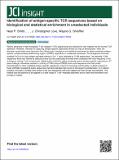| dc.contributor.author | Smith, Neal P | |
| dc.contributor.author | Ruiter, Bert | |
| dc.contributor.author | Virkud, Yamini V | |
| dc.contributor.author | Tu, Ang A | |
| dc.contributor.author | Monian, Brinda | |
| dc.contributor.author | Moon, James J | |
| dc.contributor.author | Love, J Christopher | |
| dc.contributor.author | Shreffler, Wayne G | |
| dc.date.accessioned | 2021-10-27T20:24:20Z | |
| dc.date.available | 2021-10-27T20:24:20Z | |
| dc.date.issued | 2021 | |
| dc.identifier.uri | https://hdl.handle.net/1721.1/135626 | |
| dc.description.abstract | Recent advances in high-throughput T cell receptor (TCR) sequencing have allowed for new insights into the human TCR repertoire. However, methods for capturing antigen-specific repertoires remain an area of development. Here, we describe a potentially novel approach that utilizes both a biological and statistical enrichment to define putatively antigen-specific complementarity-determining region 3 (CDR3) repertoires in unselected individuals. The biological enrichment entailed FACS of in vitro antigen-activated memory CD4+ T cells, followed by TCRβ sequencing. The resulting TCRβ sequences were then filtered by selecting those that are statistically enriched when compared with their frequency in the autologous resting T cell compartment. Applying this method to define putatively peanut protein-specific repertoires in 27 peanut-allergic individuals resulted in a library of 7345 unique CDR3β amino acid sequences that had similar characteristics to other validated antigen-specific repertoires in terms of homology and diversity. In-depth analysis of these CDR3βs revealed 36 public sequences that demonstrated high levels of convergent recombination. In a network analysis, the public CDR3βs were shown to be core sequences with more edges than their private counterparts. This method has the potential to be applied to a wide range of T cell-mediated disorders and to yield new biomarkers and biological insights. | |
| dc.language.iso | en | |
| dc.publisher | American Society for Clinical Investigation | |
| dc.relation.isversionof | 10.1172/jci.insight.140028 | |
| dc.rights | Creative Commons Attribution 4.0 International license | |
| dc.rights.uri | https://creativecommons.org/licenses/by/4.0/ | |
| dc.source | American Society for Clinical Investigation | |
| dc.title | Identification of antigen-specific TCR sequences based on biological and statistical enrichment in unselected individuals | |
| dc.type | Article | |
| dc.contributor.department | Massachusetts Institute of Technology. Department of Physics | |
| dc.relation.journal | JCI Insight | |
| dc.eprint.version | Final published version | |
| dc.type.uri | http://purl.org/eprint/type/JournalArticle | |
| eprint.status | http://purl.org/eprint/status/PeerReviewed | |
| dc.date.updated | 2021-07-12T12:37:55Z | |
| dspace.orderedauthors | Smith, NP; Ruiter, B; Virkud, YV; Tu, AA; Monian, B; Moon, JJ; Love, JC; Shreffler, WG | |
| dspace.date.submission | 2021-07-12T12:37:57Z | |
| mit.journal.volume | 6 | |
| mit.journal.issue | 13 | |
| mit.license | PUBLISHER_CC | |
| mit.metadata.status | Authority Work and Publication Information Needed | |
